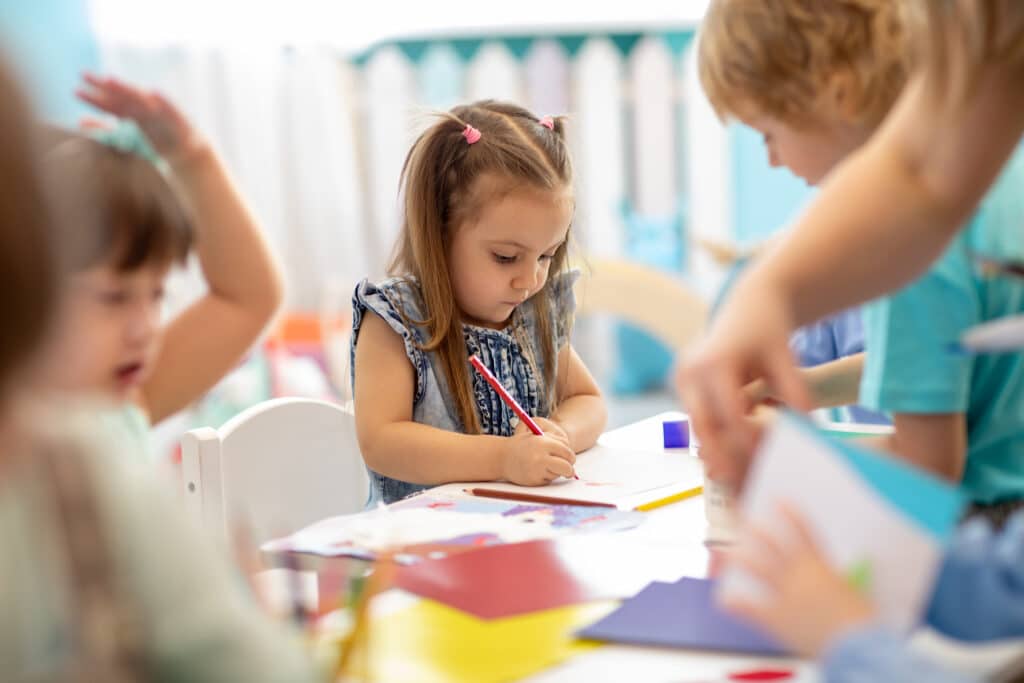Routines help children thrive and learn. Plus, effective routines and transitions can lower your students’ anxiety and guide them in starting to prepare for the next activity to keep the days moving along smoothly.
But routines and transitions don’t just happen in childcare settings. Teachers must build them into curriculum planning and be disciplined to follow the same routines day after day.
Learn how to build effective transitions and guide children with consistent routines to create a healthy learning environment in your early childhood education center.
What Are Routines and Transitions in Childcare Settings?
Before we cover how to create effective childcare routines and transitions, you first have to understand what these concepts are. Routines are the recurring, regular activities that you do each day, which is something you’re probably familiar with.
Transitions refer to how a child goes from one activity to another. These can be challenging for children because they likely have a preferred or favorite activity in the classroom. They might be hesitant to move from that preferred activity to another one. Or they might just find the change difficult due to their age and maturity.
That’s why routines and transitions go hand-in-hand. With effective routines, children can learn what to expect next to reduce the challenges associated with transitions.
Steps to Creating Effective Childcare Routines and Transitions
While you likely already have some established routines, considering how you can improve upon them might help your students. And while there is no exact science, thinking through how children engage in different activities can help smooth out transitions within your childcare center.
- Start with Independent Play
When children first arrive at your center, they’ll likely be excited to have gone from their home environment to the childcare environment. The toys are new and exciting again and older children might want to greet their friends.
Give children a chance to engage in activities that interest them. This can also help with transitions later because children will have gotten this need out of their system before needing to stick to a strict schedule.
- Get Children Outside or in Gross Motor Activities
Giving children a chance to run out some energy can prepare them for fine-motor skills activities. Outdoor or gross motor play also encourages social interactions with other children, to help children move onto group activities.
Children enrolled in a full-day childcare program should get at least 60 minutes of gross motor play. And if you have the space for it, outdoor gross motor play is the best. Even if you don’t have a formal playground, allowing children to go outside and play with balls or ride-on toys can help them build muscles and exert energy.
- Start Classroom Instruction
Now that children have had some freedom to engage in activities they enjoy and exercise their gross motor skills, you can transition to classroom instruction. Some activities might require smaller groups while others include larger groups of children.
For example, you might gather a few classrooms for story time or singing to get the day started. Large groups can help children develop skills at working in teams, paying attention despite distractions and working on interpersonal skills.
In contrast, small group activities help children engage since there are fewer children involved, and therefore, fewer distractions.
- Organize the Classroom and Schedule for Smooth Transitions
Some activities require more preparation or cleanup than others. For example, after art class, each child will need to wash their hands and clean up their space to prepare for the next activity. But in contrast, after story time, the teacher simply puts away the books and children can move to the next activity.
As you work through building an effective structure, try not to put an activity with lots of cleanup before an activity with prep work. That way, children don’t feel like all they are doing is cleaning up or getting ready for the next activity.
- Give Ample Warnings Before Changing Activities
When children are doing a science experiment, warn them that you’ll be transitioning to art class in five minutes, then again in two minutes so that once you tell them it is time, they are ready. The more you can prepare a child for transitions, the better the outcome will likely be.
Children can’t tell time yet, so they have little concept of how long they’ve been doing a certain activity or when to expect it to end. By giving multiple warnings, you can help the child prepare for the new activity and let go of the existing one.
- Offer Special Attention to New Children
Even after you put attention into creating a clear flow for the day, new children will require some time to learn the routine and get comfortable with it. Give special attention to new children to help them emotionally go through each transition.
- Monitor How Children Are Transitioning and Adjust Accordingly
You might think you have your schedule all figured out just to find out that one age group transitions easier than another. Constantly monitor how children are transitioning and adjust accordingly. This will provide the best learning environment possible for all students.
Digital Tools for Curriculum Planning
Overseeing a curriculum requires careful planning and oversight. Using digital tools to help manage the process can help make the process smoother. iCare Software has curriculum planning tools built in, which you can customize for various classrooms and requirements.
Schedule a demo now to see how the software might help you in creating effective routines and transitions in your childcare.

